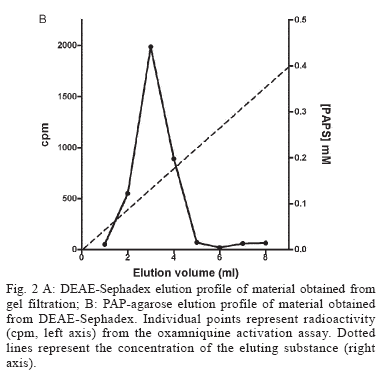Available evidence suggests that the antischistosomal drug oxamniquine is converted to a reactive ester by a schistosome enzyme that is missing in drug-resistant parasites. This study presents data supporting the idea that the active ester is a sulfate and the activating enzyme is a sulfotransferase. Evidence comes from the fact that the parasite extract loses its activating capability upon dialysis, implying the requirement of some dialyzable cofactor. The addition of the sulfate donor 3'-phosphoadenosine 5'-phosphosulfate (PAPS) restored activity of the dialyzate, a strong indication that a sulfotransferase is probably involved. Classical sulfotransferase substrates like beta-estradiol and quercetin competitively inhibited the activation of oxamniquine. Furthermore, these substrates could be sulfonated in vitro using an extract of sensitive (but not resistant) schistosomes. Gel filtration analysis showed that the activating factor eluted in a fraction corresponding to a molecular mass of about 32 kDa, which is the average size of typical sulfotransferase subunits. Ion exchange and affinity chromatography confirmed the sulfotransferase nature of the enzyme. Putative sulfotransferases present in schistosome databases are being examined for their possible role as oxamniquine activators.
Schistosoma mansoni; oxamniquine; mechanism of action; sulfotransferase; drug activation








